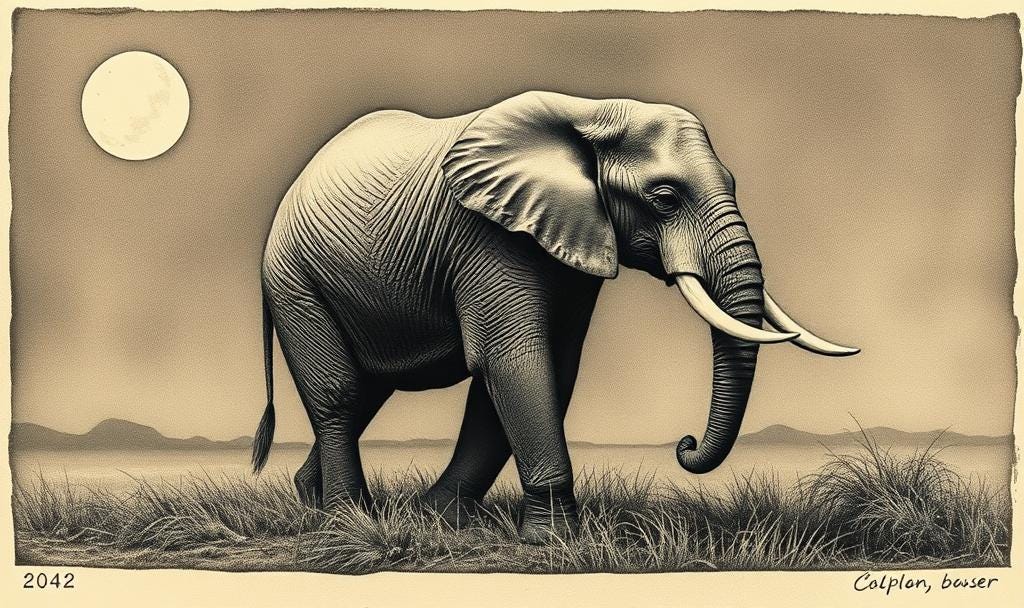The Sequence 3/10-3/16
Do Big Animals Hold the Key to Cancer Resistance?
Do Big Animals Hold the Key to Cancer Resistance?
Since cancer starts with mutated cells that keep replicating themselves and blending in with healthy tissue, one could assume that more cells means —> more opportunity for cancer. When comparing humans to some large animals, this would mean larger animals —> have more cells and therefore —> more opportunity for cancer. In reality, that association has not previously been found. Today, I’ll discuss a study that showed there is an association between body size and cancer prevalence. However, the correlation is weaker than expected. The increase in cancer risk is not proportional to the increase in body size. I’ll discuss the findings from the study as well as some of the reasons cancer rates are proportionally lower in other species compared to their sizes.
What did the new study find?
The recent study tested an idea known as Peto’s paradox, which points out that cancer rates should correlate with body size but don’t. The study analyzed body size compared with malignancy prevalence data throughout 263 species across 31 amphibians, 79 birds, 90 mammals, and 63 squamate reptiles. The results showed there is an association between body size and cancer prevalence, refuting Peto’s paradox. Prior attempts to test Peto’s paradox which found that increased body size did not correlate to an increase in malignancy prevalence only sampled a small number of species resulting in a lack of statistical power needed for robust results. Importantly, the increase in cancer risk is not proportional to the increase in body size. According to Vera Gorbunova at the University of Rochester in New York, “If you take a small animal like a mouse, and a human is maybe 100 times bigger, or an elephant is 1000 times bigger, the difference in cancer rate is not 100 times higher in humans, or 1000 times higher in the elephant”.
If cancer risks aren’t dependent on body size, what are they dependent on?
The authors distinguished the correlation between body size and malignancy prevalence from the rate of evolution of an animal’s body size and malignancy prevalence. Body size evolution varies greatly, and there is evidence that larger species have undergone repeated instances of accelerated body size evolution. Since body size evolution is associated with the evolution of multiple traits, e.g., metabolic rate, longevity etc., we might expect that high rates of body size evolution will also reflect the evolution of better cancer suppression mechanisms. We would expect that animals that get big will have developed greater mechanisms of cancer defense. The researchers in fact found that birds and mammals that underwent more total body size evolution had a decreased prevalence of malignancy, even if their present-day body size is the same. Makes sense. Natural selection would sculpt and shape species body size through time to create solutions that reduce the growing threat of cancer.
As a result, larger species of birds and mammals have grown in size without incurring the same increase in cancer prevalence as would be expected compared to smaller species. In the study, high rates of body mass evolution were associated with a 56% reduction in the predicted prevalence of malignancy in the Asian elephant. This means that the Asian elephant has the expected malignancy prevalence of an animal that is only 10% of its body size. In contrast, the long-haired fruit bat is over 30,000 times smaller than the Asian elephant, but high rates of body mass evolution are only associated with a 12% reduction in the predicted prevalence of malignancy.
What are some of the ways other animals protect against cancer?
So, how do bird and mammal species better defend against cancer if they had experienced a more rapid increase in size during their evolution? There is a lot more to find out, but studies thusfar have pinpointed genetic adaptations in elephants and whales that may protect against cancer by improving DNA repair or stopping faulty cells from dividing.
I discussed why elephants rarely get cancer in this previous Sequence. Elephants have additional copies of the TP53 gene, a tumor supressor gene that stops mutated cells from dividing so they don’t spread or eliminates those cells through cell suicide if they cannot be repaired. Elephants have 40 copies of the TP53 gene compared to the two copies humans carry! In addition to having more copies of the gene, elephant TP53 genes have evolved to work more effectively than TP53 genes in humans. Whales, another large animal with a long life expectancy and lower rates of cancer than expected, also seem to have increased DNA repair efficiency. In one study looking at how well skin cells from different animals repair a type of genetic damage in which both strands of the DNA molecule are broken, the team found that more than twice as many of the damaged bowhead whale cells repaired the breaks in DNA compared with human, cow and mouse cells. A better understanding of how some animals resist cancer could lead to new therapies for people.
What’s the takeaway?
This study challenges what we knew about the correlation between body size and malignancy and suggests that animals with high rates of body size evolution are at a lower risk of developing cancer than animals with lower rates of body size evolution. Understanding the unique properties of genes of larger animals that have had high rates of body size evolution, such as elephants and whales, can help us to understand how other animals have evolved to resist cancer. This can help us to replicate nature’s processes, and eventually create targeted medicines to protect humans from cancer in the way that some animals have naturally over time.
https://theweeklysequence.substack.com/p/the-sequence-224-32
https://www.pnas.org/doi/10.1073/pnas.2422861122
https://www.newscientist.com/article/2469720-big-animals-have-higher-cancer-risk-but-also-evolved-better-defences/
https://www.sas.rochester.edu/bio/people/faculty/gorbunova_vera/
https://education.nationalgeographic.org/resource/natural-selection/
https://www.newscientist.com/article/dn28306-elephants-almost-never-get-cancer-thanks-to-multiple-gene-copies/
https://www.newscientist.com/article/2374622-bowhead-whales-may-resist-cancer-thanks-to-superior-dna-repair-ability/
https://theweeklysequence.substack.com/p/the-sequence-220-226
https://pmc.ncbi.nlm.nih.gov/articles/PMC4858328/


